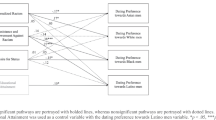Abstract
Hormonal changes associated with the human menstrual cycle have been previously found to affect female mate preference, whereby women in the late follicular phase of their cycle (i.e., at higher risk of conception) prefer males displaying putative signals of underlying genetic fitness. Past research also suggests that romantic kissing is utilized in human mating contexts to assess potential mating partners. The current study examined whether women in their late follicular cycle phase place greater value on kissing at times when it might help serve mate assessment functions. Using an international online questionnaire, results showed that women in the follicular phase of their menstrual cycle felt that kissing was more important at initial stages of a relationship than women in the luteal phase of their cycle. Furthermore, it was found that estimated progesterone levels were a significant negative predictor for these ratings.

Similar content being viewed by others
References
Baker, R. R., & Bellis, M. A. (1994). Human Sperm Competition: Copulation, Masturbation and Infidelity. Springer.
Booth, A., & Dabbs, J. M. (1993). Testosterone and men’s marriages. Social Forces, 72(2), 463. doi:10.2307/2579857.
Chiazze, L., Brayer, F. T., Macisco, J. J., Parker, M. P., & Duffy, B. J. (1968). The length and variability of the human menstrual cycle. Journal of the American Medical Association, 203(6), 89–92.
DeBruine, L. M., Jones, B. C., & Perrett, D. I. (2005). Women’s attractiveness judgments of self-resembling faces change across the menstrual cycle. Hormones and Behavior, 47(4), 379–83. doi:10.1016/j.yhbeh.2004.11.006.
Doty, R. L., Snyder, P. J., Huggins, G. R., & Lowry, L. D. (1981). Endocrine, cardiovascular, and psychological correlated of olfactory sensitivity changes during the human menstrual cycle. Journal of Comparative and Physiological Psychology, 95(1), 45–60.
Durante, K. M., & Li, N. P. (2009). Oestradiol level and opportunistic mating in women. Biology Letters, 5(2), 179–82. doi:10.1098/rsbl.2008.0709.
Durham, T. M., Malloy, T., & Hodges, E. D. (1993). Halitosis: knowing when “bad breath” signals systemic disease. Geriatrics, 48(8), 55–9. doi:10.1515/semi.1974.12.3.189.
Fehring, R. J., Schneider, M., & Raviele, K. (2006). Variability in the phases of the menstrual cycle. Journal of Obstetric, Gynecologic, and Neonatal Nursing, 35(3), 376–84. doi:10.1111/j.1552-6909.2006.00051.x.
Fleming, A. S., Corter, C., Stallings, J., & Steiner, M. (2002). Testosterone and prolactin are associated with emotional responses to infant cries in new fathers. Hormones and Behavior, 42(4), 399–413. doi:10.1006/hbeh.2002.1840.
Foerster, K., Delhey, K., Johnsen, A., Lifjeld, J. T., & Kempenaers, B. (2003). Females increase offspring heterozygosity and fitness through extra-pair matings. Nature, 425(6959), 714–7. doi:10.1038/nature01969.
Folstad, I., & Karter, A. J. (1992). Parasites, bright males, and the immunocompetence handicap. American Naturalist, 139(3), 603–622.
Gangestad, S. W., & Thornhill, R. (1998). Menstrual cycle variation in women’s preferences for the scent of symmetrical men. Proceedings of the Royal Society B: Biological Sciences, 265(1399), 927–933. doi:10.1098/rspb.1998.0380.
Gangestad, S. W., Simpson, J. A., Cousins, A. J., Garver-Apgar, C. E., & Christensen, P. N. (2004). Women’s preferences for male behavioral displays change across the menstrual cycle. Psychological Science, 15(3), 203–207. doi:10.1111/j.0956-7976.2004.01503010.x.
Garver-Apgar, C. E., Gangestad, S. W., Thornhill, R., Miller, R. D., & Olp, J. J. (2006). Major histocompatibility complex alleles, sexual responsivity, and unfaithfulness in romantic couples. Psychological Science, 17(10), 830–5. doi:10.1111/j.1467-9280.2006.01789.x.
Haselton, M. G., & Gangestad, S. W. (2006). Conditional expression of women’s desires and men’s mate guarding across the ovulatory cycle. Hormones and Behavior, 49(4), 509–18. doi:10.1016/j.yhbeh.2005.10.006.
Haselton, M. G., & Miller, G. F. (2006). Women’s fertility across the cycle increases the short-term attractiveness of creative intelligence. Human Nature, 17(1), 50–73. doi:10.1007/s12110-006-1020-0.
Havlicek, J., Roberts, S. C., & Flegr, J. (2005). Women’s preference for dominant male odour: effects of menstrual cycle and relationship status. Biology Letters, 1(3), 256–9. doi:10.1098/rsbl.2005.0332.
Hill, K., & Hurtado, A. M. (1996). Ache Life History: The Ecology and Demography of a Foraging People. New York: Aldine.
Hughes, S. M., Harrison, M. A., & Gallup, G. G. J. (2007). Sex differences in romantic kissing among college students: An evolutionary perspective. Evolutionary Psychology, 5(3), 612–631.
Hugill, N., Fink, B., & Neave, N. (2010). The role of human body movements in mate selection. Evolutionary Psychology, 8(1), 66–89.
Jones, B. C., Little, A. C., Boothroyd, L., Debruine, L. M., Feinberg, D. R., Smith, M. J. L., Cornwell, R. E., et al. (2005a). Commitment to relationships and preferences for femininity and apparent health in faces are strongest on days of the menstrual cycle when progesterone level is high. Hormones and Behavior, 48(3), 283–90. doi:10.1016/j.yhbeh.2005.03.010.
Jones, B. C., Perrett, D. I., Little, A. C., Boothroyd, L. G., Cornwell, R. E., Feinberg, D. R., Tiddeman, B. P., et al. (2005b). Menstrual cycle, pregnancy and oral contraceptive use alter attraction to apparent health in faces. Proceedings of the Royal Society B: Biological Sciences, 272(1561), 347–54. doi:10.1098/rspb.2004.2962.
Jones, B. C., DeBruine, L. M., Perrett, D. I., Little, A. C., Feinberg, D. R., & Law Smith, M. J. (2008). Effects of menstrual cycle phase on face preferences. Archives of Sexual Behavior, 37(1), 78–84. doi:10.1007/s10508-007-9268-y.
Lens, I., Driesmans, K., Pandelaere, M., & Janssens, K. (2011). Would male conspicuous consumption capture the female eye? Menstrual cycle effects on women’s attention to status products. Journal of Experimental Social Psychology, 4–7. doi:10.1016/j.jesp.2011.06.004
Lenton, E. A., Landgren, B., & Sexton, L. (1984). Normal variation in the length of the luteal phase of the menstrual cycle: identification of the short luteal phase. BJOG: An International Journal of Obstetrics and Gynaecology, 91(7), 685–689. doi:10.1111/j.1471-0528.1984.tb04831.x.
Little, A. C., Jones, B. C., & Burriss, R. P. (2007). Preferences for masculinity in male bodies change across the menstrual cycle. Hormones and Behavior, 51(5), 633–9. doi:10.1016/j.yhbeh.2007.03.006.
Manning, J. T., Barley, L., Walton, J. C., Lewis-Jones, D. I., Trivers, R. L., Singh, D., Thornhill, R., et al. (2000). The 2nd:4th digit ratio, sexual dimorphism, population differences, and reproductive success. evidence for sexually antagonistic genes? Evolution and Human Behavior, 21(3), 163–183.
Meston, C. M., & Frohlich, P. F. (2000). The neurobiology of sexual function. Archives of General Psychiatry, 57(11), 1012–30.
Nicholson, B. (1984). Does kissing aid human bonding by semiochemical addiction? British Journal of Dermatology, 3, 623–627.
Pause, B. M., Sojka, B., Krauel, K., Fehm-Wolfsdorf, G., & Ferstl, R. (1996). Olfactory information processing during the course of the menstrual cycle. Biological Psychology, 44(1), 31–54.
Penton-Voak, I. S., Perrett, D. I., Castles, D. L., Kobayashi, T., Burt, D. M., Murray, L. K., & Minamisawa, R. (1999). Menstrual cycle alters face preference. Nature, 399(6738), 741–2. doi:10.1038/21557.
Pillsworth, E. G., Haselton, M. G., & Buss, D. M. (2004). Ovulatory shifts in female sexual desire. Journal of Sex Research, 41(1), 55–65. doi:10.1080/00224490409552213.
Pollet, T. V., van der Meij, L., Cobey, K. D., & Buunk, A. P. (2011). Testosterone levels and their associations with lifetime number of opposite sex partners and remarriage in a large sample of American elderly men and women. Hormones and Behavior, 60(1), 72–77. doi:10.1016/j.yhbeh.2011.03.005.
Puts, D. A. (2005). Mating context and menstrual phase affect women’s preferences for male voice pitch. Evolution and Human Behavior, 26(5), 388–397. doi:10.1016/j.evolhumbehav.2005.03.001.
Regan, P. C. (1996). Rhythms of desire: The association between menstrual cycle phases and female sexual desire. Canadian Journal of Human Sexuality, 5, 145–156.
Rhodes, G. (2006). The evolutionary psychology of facial beauty. Annual Review of Psychology, 57, 199–226. doi:10.1146/annurev.psych.57.102904.190208.
Roberts, S. C., & Little, A. C. (2008). Good genes, complementary genes and human mate preferences. Genetica, 134(1), 31–43. doi:10.1007/s10709-008-9254-x.
Rule, N. O., Rosen, K. S., Slepian, M. L., & Ambady, N. (2011). Mating interest improves women’s accuracy in judging male sexual orientation. Psychological Science. doi:10.1177/0956797611412394.
Stricker, R., Eberhart, R., Chevailler, M.-C., Quinn, F. A., Bischof, P., & Stricker, R. (2006). Establishment of detailed reference values for luteinizing hormone, follicle stimulating hormone, estradiol, and progesterone during different phases of the menstrual cycle on the Abbott ARCHITECT analyzer. Clinical Chemistry and Laboratory Medicine, 44(7), 883–7. doi:10.1515/CCLM.2006.160.
Thornhill, R., & Gangestad, S. W. (1999). The scent of symmetry: A human sex pheromone that signals fitness? Evolution and Human Behavior, 20(3), 175–201. doi:10.1016/S1090-5138(99)00005-7.
Wedekind, C., Seebeck, T., Bettens, F., & Paepke, A. J. (1995). MHC-dependent mate preferences in humans. Proceedings of the Royal Society B: Biological Sciences, 260(1359), 245–9. doi:10.1098/rspb.1995.0087.
Wilcox, A. J., Dunson, D. B., Weinberg, C. R., Trussell, J., & Baird, D. D. (2001). Likelihood of conception with a single act of intercourse: providing benchmark rates for assessment of post-coital contraceptives. Contraception, 63(4), 211–5.
Wlodarski, R. & Dunbar, R. I. M. (2013) Examining the possible functions of kissing in romantic relationships. Archives of Sexual Behavior. doi: 10.1007/s10508-013-0190-1.
Acknowledgments
The authors would like to thank Eiluned Pearce for early document proofing. RW and RD are both supported by a European Research Council Advanced Grant to RD.
Author information
Authors and Affiliations
Corresponding author
Rights and permissions
About this article
Cite this article
Wlodarski, R., Dunbar, R.I.M. Menstrual Cycle Effects on Attitudes toward Romantic Kissing. Hum Nat 24, 402–413 (2013). https://doi.org/10.1007/s12110-013-9176-x
Published:
Issue Date:
DOI: https://doi.org/10.1007/s12110-013-9176-x




